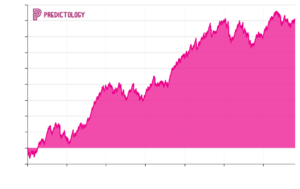

Lay The Draw (LTD) was one of the most popular football betting (and trading) strategies on Betfair. It became incredibly popular in the early 2000s, partly because it’s a relatively simple strategy to implement and was used by both inexperienced and professional bettors.
However, because it has been used for so many years already, and with the built in efficiency of the Betfair markets, many do question its effectiveness.
Despite of these concerns, we are of the belief that you absolutely can still profit from this strategy.
It may not be enough, on it’s own, to allow you retire on your betting profits, but it can still generate some healthy returns, particularly with the help of Predictology.
To be successful though, there are a few factors that you need to consider before you use the strategy. So let’s start by looking at each one of these.
What is Lay The Draw?
As the name suggests, in lay the draw, you bet against a draw happening in the match. You win the bet if the final outcome of the game is anything other than a draw. Simple right.
In fact if you look to trade the draw, it’s even easier. Before kick-off, you place a lay bet on the draw, wait until the first goal is scored, and then place a back bet on the draw as soon as that happens.
In a typical football game, the odds that there will be a draw is around 3.5 – 4 prior to kick off. However, once a goal is scored, the probability of a draw happening increases as high as 6.0-8.0. The likelihood of a draw becomes less likely and thus the odds for winning increases considerably.
Again keep in mind that LTD will fail if the first goal is never scored. The odds that a draw will happen gradually but continuously decreases, which means a loss for the trader who has laid the draw.


LTD Profit Potential and Benefits
Lay the Draw isn’t a sure-fire strategy for every match and choosing the right games are key.
Naturally you would not want to place any bet or trade without having some knowledge and reasoning of why the bet or trade will win. Just laying the draw blindly will not work.
There are 2 possible ways you can increase your chances with this strategy.
The first is to bet on a 0-0 draw so that when the game ends up goalless, you can still earn some money from the 0-0 bet. You can liken it to buying an insurance policy. There are obvious downsides to this which I’ll come to later.
The second way is riskier but is more profitable. Prior to kick-off, you need to know if the game you will be betting on will likely be a high scoring one. If it is, go ahead and bet. If the game is likely to be low scoring, it is best to forego placing the lay bet.
Before placing your bet, here are some factors to consider:
- Head-to-Head Meetings. Have the two teams had recent matches? What was the result?
- Recent Scores. Have the teams drawn recently? Any goalless marches?
- Key players missing. Check if one of the team’s top goal scorers is missing from the lineup.
- Average goal time. How long does it take the team to score a goal?
These are common factors and trends that many punters will look at. However, there is a smarter way to do this, which Predictology can help you with, and we’ll take a look at this later in the article.


LTD Challenges And Issues
The strength of both teams can be an important consideration in a Lay The Draw strategy. For example, if one team is considerably better than their opponent, it would be wise not to place a bet on the game.
Bettors always expect the favoured team to score first yet if the non-favourite scores first, the odds for the draw are unlikely to increase at this point.
Also, you need to consider your ability to be able to act fast when doing any kind of in-play betting. If one of the teams scores the first goal, you need to be able to get out of the trade quickly, in case the other team scores an equaliser quickly. If the score quickly becomes 1-1, you have missed your opportunity to lock in a profit.
When To Lay The Draw
The general idea in any LTD strategy is to avoid the draw. If we factor in that the draw will happen in approximately 30% of matches, it means that your chance of winning around 70%. However, these statistics usually don’t provide the full picture.
In order to maximise your draw laying, you may look to pick matches with clear a favourite or high scoring teams. In matches with clear favourites, the odds will be something similar to 1.75 – 4.0 – 5.20 (1×2).
When playing at home, favourites usually won’t settle for a draw with a minor opponent. But keep in mind that you need to have an estimated 75% win rate to profit.
Naturally, you should try to avoid Laying The Draw when a draw will be a suitable result for both teams and there isn’t much difference between them.
Score Is Still 0-0 At Halftime
If you are confident that a game will not finish in a draw (or at least have one goal), it can be advisable to wait until half time before starting your bet / trade. Statistically we know that the first half will average one goal, while the second half will average two goals. So we have a higher probability of a goal in the second half, yet our cost (liability) to lay the draw is much lower, often below 3.00 at half time, compared with the pre-match odds.
This is probably the best lay the draw strategy, and you can usually include the 1-1 scoreline in this as well. Its easy for new and experienced traders as there is no significant decision to make. If the scores are level on the match you have chosen, lay the draw at half time.
The additional benefit with this strategy if that even if the underdog scores first, the odds will likely still be low enough to exit your trade and profit. All you need is to either watch the first half or identify your match pre-kick off.
Lay the draw at 60 minutes
This strategy is more about trusting your instincts or knowledge about football. You need to have watched the match and crunch numbers to be able to succeed here. This will determine your entry point. For example, if the favoured team has still not scored a goal, you may need to do some tweaks to trigger your trading.
Another example is when a match it is tight, yet you can see the pace of the game is changing from one team to another – in other words, it is becoming more open and more attacking intent is being shown. You can then use these events as your entry point.
Lay The Draw Strategies
Using the right strategy increases your chances of becoming profitable. Different matches present different scenarios so you need to adjust your strategy. Here are five common Lay The Draw strategies used to profit when trading the draw.
1. Laying the draw pre-match
As you would expect, you place your lay bet on a team before the start of a match and wait for a and wait for the result of the match. Anything but a draw and you win your stake.
If the match ends in a draw, then you lose the liability on your bet.
Alternatively, you can treat it as a trade by playing your lay bet before kick off and then your back bet right after a goal is scored. Here, you only lose your bet when the match ends in a goalless draw. In most cases, you can achieve around a 30% – 40% of your stake as profit.
The longer the game goes without a goal the more the odds for a draw will drop. Many bettors and traders will look to avoid 100% of their stake, by choosing a stop/loss point when you decide when to cash out and accept loss. The common approach is usually around the time the odds reach 2.0 odds for the draw, which is usually around 65-70 minutes mark for an average match.
2. Laying the draw at halftime
This is similar to the first strategy except that you lay the draw on a match at half time. This is a safer option because your exposure is up to half what is was by betting on the draw pre-match.
3. Laying the score at half-time.
This is an alternative strategy where you don’t bet on the draw result but on the draw score. With this strategy, the exposure is higher because accurate scores have higher odds but the probability of winning is also higher. If there is still no goals at halftime, the odds at 0-0 for a correct score drops to 4.5 from 10.0 in pre-match.This is useful if you are unable to watch the match and what a “set and forget” approach. You can even set this up before a game starts
4. Laying a half-time draw. With this strategy, you place a pre-match bet that the match will not be a draw at half-time. This strategy offers lower exposure as the draw odds for the halftime is usually at 2.0. However, the risk is that you are requiring a first half goal and no team ever needs to win the first half.
5. Lay the 0-0 for halftime correct score.
Similar to (4), if you are confident that there will be at least one goal in the first half, this strategy is can prove profitable. Usually the odds of a 0-0 correct score at halftime is much smaller than at full-time.
Exit Strategies
When it comes to sports betting, you need to keep in mind that things will not always work out as planned. You can’t always hope for a late game winner because the odds of a goal being scored in the last 10-15 minutes drops tremendously.
It comes down to good bankroll management and it is better to preserve your stake and bankroll for another match where the conditions may be better for you to profit.
So when is the best time to exit and take your profit?
Here are 2 exit strategies that you may wish to consider to help you maximise your profits.
1. Waiting for a 2-goal lead
With a 2-goal lead, the price for a draw increases as well as your chance to bring in some significant profits. With this strategy, you can even wait for the game to finish since you are already assured of maximum possible profit. You will only react if the 2-goal advantage has been reduced to a single goal.
However, this can be risky since you still have to watch the game after the first goal and wait for a second goal. While, in most cases, the lead will not be extended, there is still a chance that the trailing team can equalize to put you back to a draw position. At this point, your losses increase.
2. Removing the risk from the draw
In this strategy, you remove all possible risks from a draw by backing the draw after a goal is scored. This increases your potential winnings by 10 – 20%. However, if the match does end up in a draw, you don’t get your profits at all.
3. The underdog scores first
The underdog scoring the first goal can make your bet or trade a little bit tricky and you need to be prepared for such an eventuality.
In most cases, punters will react depending on the circumstance. If the goal was from a lucky break, most will assume that the favoured team can still score the equaliser. However, the odds of a draw can drop at this point.
If this happens, you may consider the in-play statistics and judge whether the favourite still looks likely to turn the game around. But you do run the risk of the underdog scoring again, while you are relying on the favourite to score twice, not just once, for you to get your target profit.
In these situations, it can be better to simply cash out for a small profit or loss and move on to the next game.
There is always another game and you never have to wait long for a suitable trading or betting opportunity.
Should you ever use “insurance?” with Lay The Draw?
Insurance provides an opportunity for bettors to protect themselves against a loss in case there are no goals. Personally I feel that Insurance just eats into your profit margins and leads to deminishing returns over time.
That said, here are some insurance options that you may wish to consider
Lay the draw and back 0-0 insurance
Here you are betting that the match will end at 0-0. This insurance bet serves as a pseudo-backing for the favourite to score the first goal. However, the challenge with this strategy is that if the underdog scores, you not only lose your wager but also your insurance bet.
Lay the draw and back 1-1 insurance
This is based on the idea that 1-1 is actually the more likely outcome when a match ends in a draw. The 1-1 score occurs 11% on the average compared to 8% for the 0-0. While most football traders are confident they can avoid a 0-0 match, they also cover the 1-1 score to increase their profits.
One problem with this strategy is that your losses could increase should the game end up in a 0-0 draw. Also, you need to react if the match goes to 2-1 or 3-2 since you did not have cover on either the 2-2 or 3-3 draws. If this happens, you still need to exit the trade.
Tips & Tricks For Laying The Draw
Laying the Draw can be a profitable venture when successfully implemented. Here are some tips on how to increase your profits from the strategy:
Find your BEST entry point
While the best time to lay the draw is some time during the second half, this may vary depending on the circumstance. You only need 1 goal to get into a profitable position so monitor the match very closely on when a goal will likely arrive. The later in the match the goal arrives, the lower the risk and the bigger your profit potential.
Watch your strike rate
To achieve long-term profitability, a high strike rate will be required. Depending on the price of your entry point, a strike rate of 70-80% can be very realistic. However, laying the draw at a price like 2.0 may only need a 60% strike rate for long-term profitability. Awareness of your strike rate and the odds that you enter at are vital to ensuring maximum profits.
Record your trades
As with any other trades, you should keep a record of all the matches you trade. This will allow you to spot patterns and discover matches where you excel at trading and picking opportunities. This will depend on the individual. You will find it hard to improve if you do not have any direction.
Can Predictology Help You Profit From Laying The Draw?
The simple answer to this is a resounding… YES!
For example, ALL Predictology members receive, as part of their membership, access to one of our Lay The Draw prediction models








2 thoughts on “Can You Still Profit From LayIng The Draw?”